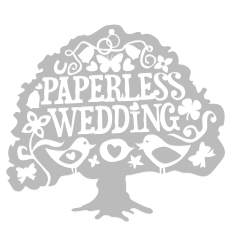Traditions are a big part of a wedding. When we decided to get married back in 2009 we broke the long-standing tradition of the paper wedding invitation by having a Paperless Wedding. We chose this for many reasons, from it being cheaper, through to our bit to save the planet!
According to an article written by Martin Karen, in actual fact the original traditionaln wedding invitation wasn’t paper based. Most people agree that the first invitations began in the 12th Century with the town crier, who would walk through the town and announce important events to the public. Word of mouth was an important means of spreading news, and anyone within hearing of the town crier was, by default, invited to the wedding! So they had Paperless Weddings back then!

Sir Samuel Luke Fildes, 1883
During the Middle Ages, when great numbers of people were illiterate, noble families would commission monks to hand-letter and illuminate wedding announcements in calligraphy. These invitations often included a family crest or coat of arms, an important symbol that helped identify the family of the engaged couple. Many people today include such a family crest or coat of arms on their wedding invitations as a nod toward tradition and heritage.
In the 18th century in England, handwritten social invitations were first used by the aristocracy. Only kings and queens and other members of high society received invitations to social events. Usually the invitations were written by a butler or ladies maid. Having them handwritten was a sign of education. Even after the modern printing press was discovered, many aristocrats continued to have their invitations handwritten for this purpose. The handwriting itself was a work of art. Much time and planning was given for this process. Calligraphy pens were used, which gave letters dimension; there were thick and thin lines in each word.

1890 wedding invitation
Modern wedding invitations became more widely-used after World War II. The development of thermographic printing allowed more sophisticated designs to be stamped on invitations at less cost than tradition engraving. Thermographic printing creates a raised effect that is often used for letterheads, business cards, and even Braille. Its versatility lends itself perfectly to the artistic nature of modern wedding invitations. However it still uses a lot of paper!

Today, invitations are often creative and individual expressions of the couple’s personality. People are experimenting a lot more and moving away from paper based invites to sending photography, videos and websites. We hope through Paperless Wedding you can be different, have a website and send wedding invitations digitally to your guests. Upload photos and add extra pages for all the information you want to share with your guests. If the town crier had of been crying today he would be very hoarse with all the information that is now sent out.



